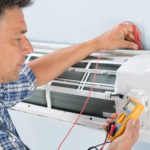 Your phone is smart, but is your HVAC system also? In 2015, the number of people able to answer yes will grow significantly. “Smart” has become a driving force throughout the HVAC industry.
Your phone is smart, but is your HVAC system also? In 2015, the number of people able to answer yes will grow significantly. “Smart” has become a driving force throughout the HVAC industry.
Whether through the offering of increasingly interactive HVAC devices, or simply greater efficiency, HVAC is rapidly getting smarter.
House apps
Of course, smartphone apps have been controlling house temperatures for a while now, but the flexibility of those systems is quickly increasing. Some products give users the ability to place sensors throughout a home, allowing people to grab real-time temperatures remotely through phones, tablets or other smart devices.
That data can be recorded to help systems recognize patterns and relationships and better predict heating and cooling requirements. They allow you to turn HVAC equipment on and off based on home-wide averages as well as the conditions in specific spaces, your proximity to home, or your own changeable schedule. This includes controlling the intake/outtake of HVAC vents to increase the comfort of the resident.
Air quality monitors
Next up, developers are working on apps that will help monitor air quality in a home. Special, cost-effective sensors are being developed in Europe, designed to analyze particles in the air. They may help our smart devices to identify dangers like radon gas which has been linked to cancer, and is present in buildings throughout the world.
People with allergies or asthma may also be able to use air quality data to help reduce their own suffering.
Smartchips
HVAC energy efficiency has improved in previous years, and 2015 will be no exception. New systems will clearly deliver cost saving by using so-called smartchips to upgrade existing equipment. A smartchip can calculate how much hot or cold air remains in a HVAC system after shutoff. It can then keep the blower running for up to two minutes to make sure energy is not wasted.
On compressor based systems like air conditioners, a smartchip will also shut off the compressor once the coils reach their normal operating temperature. Most HVAC systems continue to run the compressor even though the temperature of the coils remains stable. By turning off the compressor, the smartchip saves energy until it’s needed again to heat or cool the coils.
It may seem like smart HVAC technology is still years away from mainstream use, but recent history would suggest that it will not be long. Remember when Apple introduced its iPhone smartphone in June of 2007? By 2010, it seemed almost everyone had a touchscreen smartphone in their pocket.
For HVAC professionals, keeping up with technology can be a challenge, but failing to get smart could be a costly mistake.



